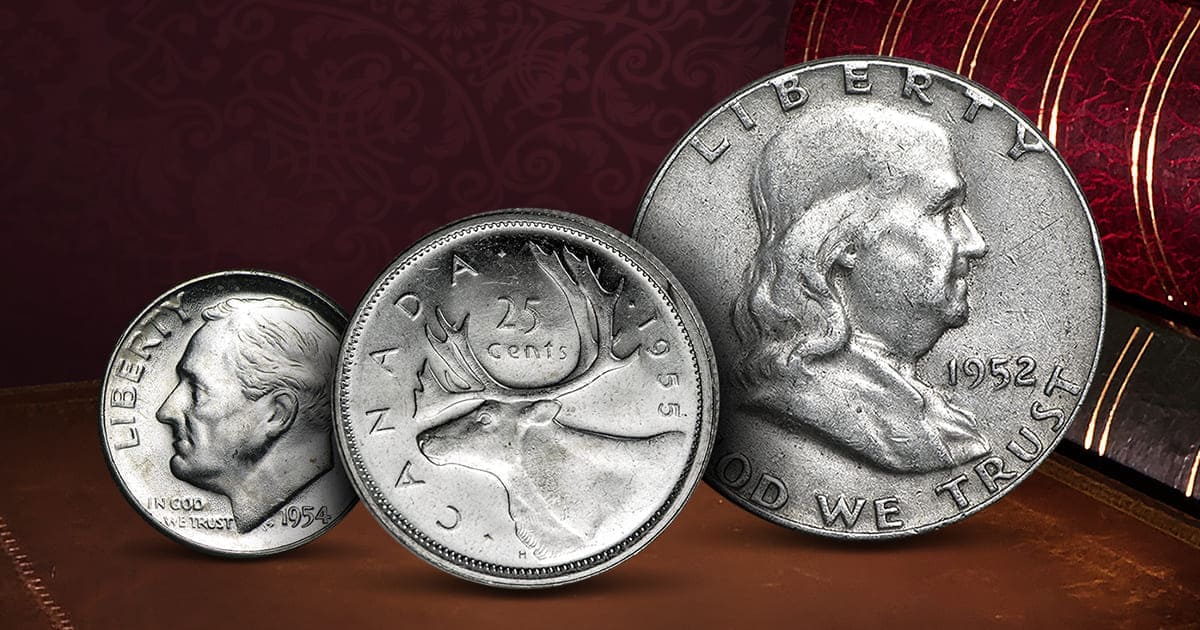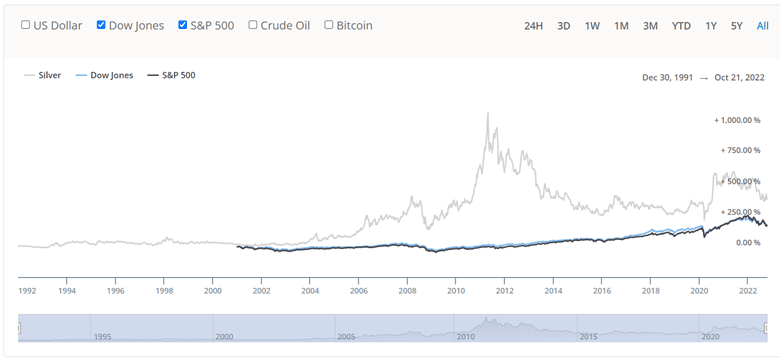
What is “Junk Silver” & Why It Might Be Just What You Need
“Junk silver” is a misnomer. Many of America’s coins circulating before 1965 were made of 90% silver. They are now called “junk silver” because their value is solely based on their metal content instead of collectibility or condition. “Junk” just means they are not numismatic, but make no mistake, Junk silver coins still have value and a place in portfolios.
Four basic types of coins are sold as “junk silver”:
- 90% silver: U.S. dimes, quarters, and half dollars, dated before 1965.
- 40% silver: Kennedy Half Dollars dated 1965 through 1969; the San Francisco Mint Eisenhower (Ike) dollar coins struck between 1971 and 1976; and 1976-S San Francisco Mint Washington Quarters and Kennedy Half Dollars in proof are also made of 40%, but usually the Ike Dollars and other 1976-S proof coins are worth a considerable premium over their silver content.
- 35% silver War Nickels – Jefferson Nickels dated from 1942 to 1945. There are 1942 and 1945 Jefferson Nickels that are not War Nickels. A large letter on the reverse over Monticello easily identifies this silver version of War Nickels. If there is no large “P, D, or S” it is not a War Nickel. The coins contain 35% silver since nickel was an element that was used in many airplane parts during World War II. In 1946, these nickels returned to their original composition of .750 copper and .250 nickel.
- 80% Canadian silver is Canadian silver dimes, quarters, and half dollars, dated before 1968 when Canada stopped striking silver coins.
“Junk silver,” “90% silver,” and “old U.S. silver,” are all names for the same type of coins. Before 1965, all United States dimes, quarters, and half dollars were made of 90% pure silver and were the coins used in everyday commerce. There was no premium for the silver content until about 1966. These coins are sometimes referred to as junk silver because their actual value is based primarily upon the amount of silver metal content in each coin, rather than their collector value for being 60 years or older.
Historical Background
Regarding 90% silver coins, many older Americans remember these coins being in circulation all the time. While most of these coins are only valuable for their silver content, some of the older types – Barber dimes, quarters, and half dollars, for example – may have a higher premium due to their age and collectability.
With silver removed from coinage in 1965, many Americans began hoarding the 90% silver coins in circulation. The government did not recall these coins – the price of silver increased, and many were melted for their silver value. While no one knows what percentage of these 90% silver coins were melted, some estimates claim up to 40% of all junk silver coins may have been melted during the late 1960s.
When the Hunt Brothers attempted to corner the silver market, it triggered a U.S. government reaction. This reaction involved melting bullion in 1979 and 1980, with some historical accounts labeling it the Great Silver Melt of 1980. The amount of silver melted is disputed, but some sources claim many 55-gallon drums of silver coins were processed. And more recently, junk silver was likely to melt down during the housing crisis and recession years of 2008-2011.
Who Buys Junk Silver and Why
Silver investors, silver stackers, and silver accumulators purchase these types of coins because they want to buy cheaply. These individuals have similar goals. Investors try to balance their investment portfolios, and a hard asset like silver can play an important role. Stackers and accumulators also believe that, but they are focused on trying to buy the cheapest silver available – which is often junk silver.
They buy junk silver by coin, roll, or bag. Because premiums are so low on junk silver even the most sophisticated silver investors find these coins attractive and hold some of them in their diversified investment portfolio.
These coins are also desirable to those called “preppers,” which is short for “doomsday preppers”. Preppers believe that national or global catastrophes that disrupt or dismantle the financial system are probable, and they want to be prepared. Besides ammunition, canned food, potable water, and survival instincts, junk silver gives them a way to barter real silver for the important items needed to survive in a worst-case scenario.
For preppers, our paper currency is considered untrustworthy in a true crisis. They regard government-issued greenbacks as a promise to pay by a government that may not be around. These silver coins are actual money, come in small denominations (as low as ten cents face value), and are made of silver, so they will always have value. During a global catastrophe, their value should only increase.
Is Junk Silver a Good Investment?
Well, the answer to that question depends on your point of view and your investment philosophy. Junk silver prices are tied to the spot price of silver. How has silver done as an investment over the years?
The chart below displays the price movement of silver, the Dow Jones Industrial Average (DJIA), and the Standard & Poors’ 500 (S&P 500) over thirty years from 1992 to 2022. Over that time, the DJIA increased by 209%. The S&P 500 increased 174.60%. Not bad returns!
But silver, over that same time period, increased by 395.8%. And had you sold it during its height in April-May of 2011, silver was up over 1000%. That would have been an amazing return on your investment.

So, if the value of silver goes up, the value of junk silver also goes up. But if it goes down, the value of your junk silver also decreases. Still, over a very long-term period, silver did nearly two times better than DJIA and more than twice as well as the S&P 500.
When you buy and when you sell your silver will affect your returns to a great degree. We encourage all customers purchasing silver as an investment vehicle to do an appropriate amount of research ahead of time.
Understanding the Price of Junk Silver & Where to Buy It
Coin and bullion dealers like APMEX generally always have junk silver in stock as there is a constant demand for this type of silver. Junk silver coins can be purchased in increments: $1 face value, $5 face value, $10 face value, $100 face value, or even $1,000 face value.
Junk silver coins can also be purchased individually, by the dollar increments above, by the roll, or by the bag. Each $1 face value of junk silver contains approximately .715 of a troy ounce of pure silver.
|
Face Value |
Average Troy Ounces of Silver |
|
$1.00 |
.715 |
|
$10.00 |
7.15 |
|
$50.00 |
35.75 |
|
$100.00 |
71.50 |
|
$250.00 |
178.75 |
|
$500.00 |
357.50 |
|
$1,000.00 |
715.00 |
The amounts of pure silver contained in these coins vary slightly depending on how worn each of the coins happens to be.
Junk silver is easy to buy at APMEX or other coin or bullion dealers. When the time comes to sell your junk silver, APMEX is always a strong buyer for junk silver and all types of coins and bullion items, as are coin and bullion dealers all across the country
Sometimes, you may be able to buy very worn Morgan or Peace Silver Dollars as junk silver. These coins carry a higher premium than the average junk silver coins as they have some historic numismatic (collector) value. Each coin has a higher silver content than junk silver’s $1.00 face value.
Morgan Silver Dollars were struck between 1878 and 1921. Peace Silver Dollars were struck between 1921 and 1935. Each silver dollar contains .77344 of a troy ounce of pure silver.
Consider adding some junk silver to your investments; your diversified holdings’ return on investment may be higher.





